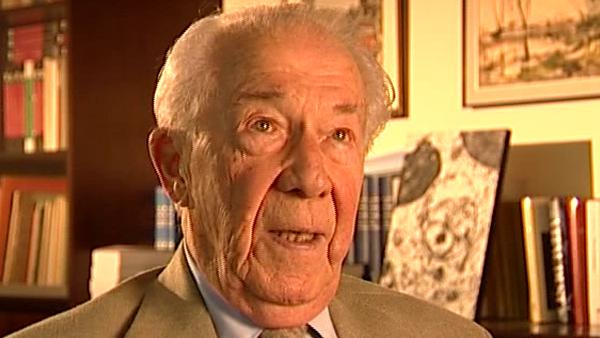NEXT STORY

Purifying enzymes and visiting labs
RELATED STORIES

NEXT STORY

Purifying enzymes and visiting labs
RELATED STORIES


|
Views | Duration | |
|---|---|---|---|
| 21. Writing to Carl Cori, and crystallised insulin | 206 | 03:14 | |
| 22. The Lilly Research Labs: Making a re-discovery | 203 | 03:40 | |
| 23. 'You will get a fur coat when I get a Nobel Prize' | 230 | 05:01 | |
| 24. Becoming Professor of Biochemistry at Louvain | 185 | 01:52 | |
| 25. Setting up a lab: A grant from Eli Lilly and Company | 151 | 02:40 | |
| 26. Setting up a lab: Difficulties getting equipment | 149 | 02:51 | |
| 27. Glucose 1-phosphate and glucose 6-phosphate | 187 | 03:55 | |
| 28. Purifying enzymes and visiting labs | 144 | 03:05 | |
| 29. The Rockefeller Institute and Albert Claude | 1 | 206 | 04:34 |
| 30. Centrifugal fractionation | 187 | 02:12 |


And that piece of research, I had decided, was to characterise a phosphatase that the Coris had described. I don't have to tell you that when glycogen is broken down it is first broken down by phosphorylase into glucose 1-phosphate. Glucose 1-phosphate is converted by an enzyme called phosphoglucomutase into glucose 6-phosphate and then the glucose is released by splitting of glucose phosphate by this phosphatase. Well, the Coris didn't know whether the phosphatase acted on glucose 1 or on glucose 6, so I decided we would go after that, because this was a specific liver enzyme, and it was an enzyme that could possibly interfere with the action of insulin because insulin... I mean, glucose is converted to glucose 6-phosphate when... when it is taken up, and so the phosphatase could eventually antagonise this action of insulin. Well, we did discover that the enzyme was specific for glucose 6-phosphate – had no effect on glucose 1-phosphate – and that was our first little discovery; nothing really very earth shattering, just... it was just simple... simple enzymology, but simple enzymology in those days was a little different from what it was... what it is today. There was no Sigma companies; the Sigma Company, I have to explain, is one of the many companies today that make biological chemicals for use in the lab. Sigma Company, which was, in fact, started in St. Louis – I think in connection with the Cori lab – and so we had to make our reagents ourselves; so we needed glucose 1-phosphate and we needed glucose 6-phosphate. Well, to make glucose 1-phosphate we had to take a potato extract and add phosphate, and the phosphorylase in the potato extract would convert starch into glucose 1-phosphate. Then we had to purify and crystallise the glucose 1-phosphate, out of this mess, using the techniques that the Coris had worked out, because, as you know, glucose 1-phosphate was discovered by the Coris – it's known as the Cori-ester, or it was known as the Cori-ester. And then, to make glucose 6-phosphate, we had to take a couple of rabbits, remove their muscles, and purify from those muscles an enzyme which the Coris had also isolated, called phosphoglucosemutase. We had to make the crystal in its enzyme and then we would take part of our glucose 1-phosphate and this enzyme; the enzyme would convert 95% of the glucose 1 into glucose 6 and so we had to purify the glucose 6-phosphate, and, finally, having done all that, we could just find out whether our enzyme would act on the glucose 1 or glucose 6 or on both. Okay, so it was fun – I can tell you it was fun – but it took time.
Belgian biochemist Christian de Duve (1917-2013) was best known for his work on understanding and categorising subcellular organelles. He won the Nobel Prize in Physiology or Medicine in 1974 for his joint discovery of lysosomes, the subcellular organelles that digest macromolecules and deal with ingested bacteria.
Title: Glucose 1-phosphate and glucose 6-phosphate
Listeners: Peter Newmark
Peter Newmark has recently retired as Editorial Director of BioMed Central Ltd, the Open Access journal publisher. He obtained a D. Phil. from Oxford University and was originally a research biochemist at St Bartholomew's Hospital Medical School in London, but left research to become Biology Editor and then Deputy Editor of the journal Nature. He then became Managing Director of Current Biology Ltd, where he started a series of Current Opinion journals, and was founding Editor of the journal Current Biology. Subsequently he was Editorial Director for Elsevier Science London, before joining BioMed Central Ltd.
Tags: Sigma Company, Carl Cori, Gerty Cori
Duration: 3 minutes, 55 seconds
Date story recorded: September 2005
Date story went live: 24 January 2008